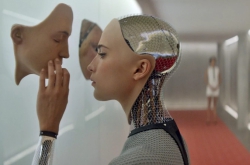Cognitive psychology
I study cognitive psychology — basically, this is about how humans form skills and what the conscience’s role in it is. The main task here is to create cognitive models of our conscious, so as to understand how thinking processes go. This field of science appeared with the first computers, around the middle of the 20th century. Scientists noticed that in a sense, human thinking is similar to how a computer works. Obviously, the idea of creating human-like robots was brought up as well. Yet, a question emerged: how to program things like feelings and emotions?
 ITMO University. Gutenberg's Lounge
ITMO University. Gutenberg's Lounge
Concept 1: Thinking is based on logic
At first, the scientists assumed that human thinking is similar to how a computer solves logical tasks and puzzles. Thus, thinking was perceived as processing information and making logical conclusions. This theory was developed by psychologists Herbert A. SimonandAllen Newell. I call this model of human conscious "The Thinker": it is a simulation of the thinking process, yet the model can't show us the process of conducting actions or decision making.
Let me explain why. For instance, a computer can solve the logical puzzle "Tower of Hanoi" using a hierarchy of possible steps. The puzzle is simple. There are three rods. On one of the rods, there are 8 disks of different diameter; the smaller disks are placed atop the bigger ones. The task is to move the disks to another rod without placing bigger disks atop smaller ones, moving only one disk at a time. The computer showed one disadvantage: as the amount of rings used in the puzzle increased, it could no longer solve it as fast as a human.
Concept 2: Human thinking is based on learning ability
The next step in researching thinking and conscience has been done when neural networks were developed. In fact, the term neural network was first used to describe the attempt to model the processes in a human brain. Basically, neural networks are sets of characteristics that are to be combined, each having a particular value. The network gives a result that does or does not match the task given by the network's organizers. If the result does not match the task, the neural link changes the values for each characteristic to get a different result. And this process is repeated until the network gives the requested result. The network "remembers" the set of characteristics that lead to the requested result, and then can define, for instance, what some image depicts. Surely, that becomes possible after many "rounds" of learning (you can read about neural networks in detail here).
 ITMO University. Ivan Ivanchei, Gutenberg's Lounge
ITMO University. Ivan Ivanchei, Gutenberg's Lounge
As of now, artificial neural networks can do image and speech recognition, they are a type of AI. Thanks to them, cognitive psychologists could understand how humans learn, how associations, semantic memory and memory in general work. I call this cognitive model "The Doer", as it reflects a human's ability to create and change.
Concept 3: Thinking is both logic and learning
Yet, it turned out that "Doers" aren't that good at solving puzzles by themselves. So, in the 90-s the psychologists decided to combine the two models to understand how a human learns and perceives reality. There is an interesting experiment demonstrating the phenomena of implicit learning. This is a process when one unintentionally gains skills without even knowing it. The researchers showed people pictures of insects and asked them to divide them into two groups. They showed one picture of an insect of the first group and one — of the second, but didn't explain the traits they'd based the classification on. At first, people couldn’t tell for sure which group an insect belonged to. They made mistakes and they were told of it. With time, they began to do it right.
This means that humans can learn to do something without being aware how they do it. Surprisingly, this ability is retained even after amnesia — it seems that in this case, the "thinker" is destroyed, but the "doer" is unaffected. Also, when one performs implicit tasks, different brain sectors are activated — not the ones that are active when one solves logical tasks. Thus, we can conclude that the hybrid model — "thinker-doer" is more exact in depicting human thinking and conscious.
 ITMO University. Ivan Ivanchei, Gutenberg's Lounge
ITMO University. Ivan Ivanchei, Gutenberg's Lounge
Depicting intuition
This model can explain intuition, as well. We are likely to feel what we call intuition when we use this implicit knowledge. Note that when we "feel" intuition, we are totally sure that we know how to do something, while we can't explain why. Another example: almost everyone has experienced this feeling when something seems really familiar, and one feels like he's seen it somewhere. In this case, the "doer" processes the signals one gets really fast, and the "thinker" interprets them as something familiar. Same thing happens when one makes aesthetic assessments — we can't explain logically, why we like or dislike some art object.
Can a computer explain this? One thing is totally clear: a computer solves tasks differently, not like a human. And the fact that a computer has bested a human in a game of go doesn't mean anything. We still don't have a full-fledged AI or a human-like machine. Programs just don't work like our brains do. I believe that without "programming" intuition, creating a human-like machine is impossible. And that would require modeling cognitive mistakes, as well — cases when the brain uses the "thinker" when it should've used the "doer" and vice-versa. By studying these mistakes, we would be able to understand how human conscious works.





